In 1975, at the age of twenty-nine, John Bennet got a job at The New Yorker, under the editorship of William Shawn. He was first placed on the copy desk. Eventually, he edited Pauline Kael, Seymour Hersh, John McPhee, Alma Guillermoprieto, Oliver Sacks, Robert Caro, Elizabeth Kolbert, Bill Finnegan, and many others. In 2001, he started teaching courses in magazine writing at Columbia Journalism School. He became, over decades, a mentor to generations of authors, editors, and students—recipients of his unimpeachable proofs and compassionate, bullshit-free counsel. Shortly before he died—of cancer, in the summer of 2022—he spoke about how life took him from a dirt farm in Athens, Texas, to literary heights, shaping some of the greatest nonfiction stories of his time.
An unofficial list of John Bennet’s aphorisms, also known as Bennetisms:
- Put the best shit at the end, the second-best shit at the beginning, and all the other shit in between.
- An editor is like a shrink. If the writer doesn’t think his editor is great, he’s totally fucked up.
- Cut the blah-blah.
- The best journalists always overreport.
- Don’t be a hero.
- Chronology is your friend.
- Read your piece out loud.
- Only shitty writers need transitions.
- The bias of journalism is coherence.
- Writing is taking life and reducing it to still life.
- “Said” is always the best attribution. (The person didn’t “chuckle,” “quip,” or, as in Victorian novels, “ejaculate.”)
- In quotes, avoid boilerplate “on message” lines that you could paraphrase just as easily.
- There are only two numbers: big numbers and small numbers.
- If there’s no fix, there’s no problem.
- Peel off one layer of the onion and you’re a genius. Peel off another layer, you’re a solipsist and people will hate you.
- You need a cosmic graf.
- Don’t nudge the reader.
- Don’t condescend to the reader.
- Don’t rob the reader of feeling emotions by reacting for them (“I started to cry”).
- When a cliché enters the reader’s brain it is shunted down a scarified tube and fails to generate new synapses.
- Remember the banana rule: it’s never “the elongated yellow fruit.”
- Readers are like cows—they just want to keep chewing what you feed them.
- The best titles are Dylan songs.
- There’s no such thing as a shared byline. Two people talk about something for hours, and then at midnight one person sits down at the typewriter and the other walks away.
- BuzzFeed facts: What are the top ten most interesting things about your subject? Make sure they’re in your article.
- Remember that the reader is blind, so you need physical descriptions of people.
- A piece with a nut graf is like a documentary with a voice-over—it means you haven’t got it all on film.
- Editing is not a spectator sport.
- Anything great about a piece is because of the writer—don’t fuck it up.
- You’re paid for your opinion.
- When it comes to rejection: you don’t really want to know why Suzy doesn’t want to go with you to the dance.
- A writer is a guy in the hospital wearing one of those gowns that’s open in the back. An editor is walking behind, making sure that nobody can see his ass.
This audio piece was edited by Amanda Darrach and Mark Van Hare.
Betsy Morais is the managing editor of CJR.



